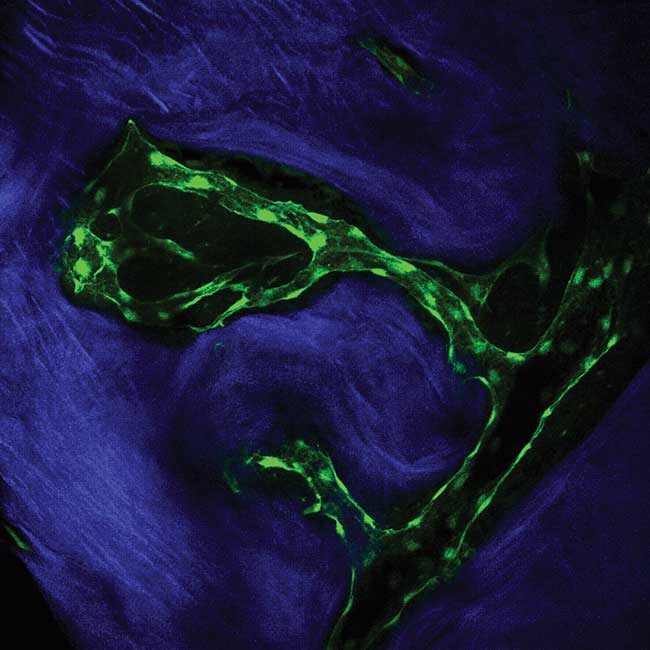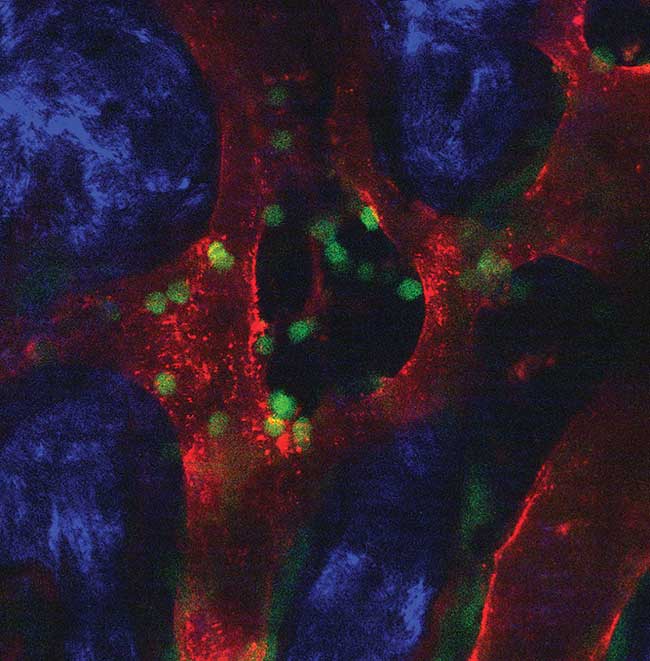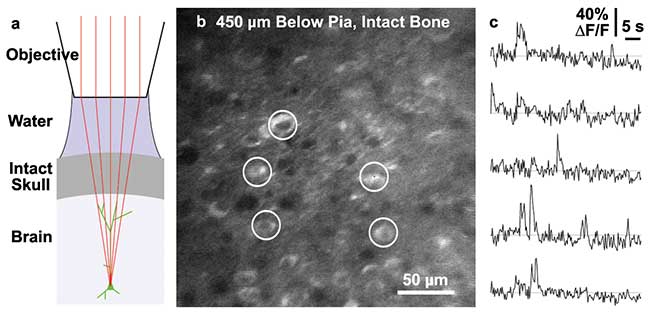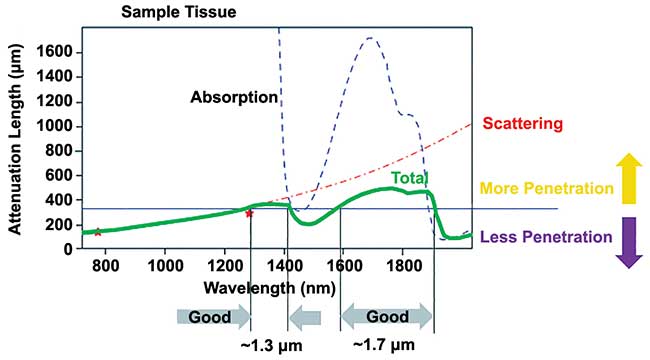Tunable ultrafast lasers enable 3D imaging and research applications ranging from neuroscience to improved understanding of stem cell transplantation.
Darryl McCoy and Marco Arrigoni, Coherent Inc.
Multiphoton imaging is widely used for live-cell imaging. Many of the applications are in neuroscience, where the overarching trends involve deeper imaging using longer wavelengths. These trends are the leading drivers behind the latest generation of ultrafast lasers based on ytterbium (Yb) fiber. However, there are numerous other applications far outside the well-publicized field of neuroscience, and these are often amply served with traditional titanium:sapphire (Ti:S) ultrafast lasers.
Gabriele Bixel and colleagues at the Max Planck Institute for Molecular Biomedicine in Muenster, Germany, are using multiphoton microscopy at two wavelengths to unravel new details about the self-implantation of stem cell transplants. They are studying this process in the cranial marrow of live mice, using two wavelengths generated from a Ti:S laser (Chameleon) and a Ti:S tunable optical parametric oscillator (Chameleon OPO).
Most stem cell transplants are allogenic, where the cells are derived from a healthy tissue-matching donor. There is an expanding use of autologous transplants, where the cells are derived from the patient and then transformed in some way in the laboratory. In all cases, the patient’s bone marrow cells are killed, and the new cells are introduced intravenously. The cells then find their way to the bone marrow and self-implant. However, there are still some fundamental gaps in our understanding of the complete self-implantation process.
“We are studying allogenic transplants in the mouse model where hematopoietic stem and progenitor cells [HSPCs] from donor mice are injected into the bloodstream of recipient mice,” Bixel said. “We focus on the early events of HSPC homing: rolling and adhesion of transplanted HSPC in bone marrow microvessels that subsequently results in HSPC transmigration to the bone marrow cavities.”
In addition to using a combination of two wavelengths, Bixel’s team employs two nonlinear imaging techniques (two-photon excitation and second harmonic generation, or SHG) to simultaneously image the HSPCs, the vessel walls and the bone structure via its collagen fibers.
The use of long wavelengths at 850 nm (from the laser) and 1100 nm (from the OPO) means that the multiphoton microscope can penetrate through the outer bone thickness, which is only 50 µm in the murine cranium. The researchers then image in the marrow region at an additional depth of 250 to 300 µm.
Blood stem cells are believed to preferentially reside in areas of low local oxygen within the bone marrow cavities. It is key to locate areas of low O2 in the bone marrow by analyzing the flow pattern of O2-carrying red blood cells in the bone marrow microvasculature. Understanding shear stress forces associated with flowing blood also is important since these are known to negatively impact the ability of cells to adhere to the vessel walls.
There are actually two types of blood vessels found in bone marrow: conventional arterial vessels and sinusoidal vessels, which are exclusive to bone marrow (Figure 1). Bixel and colleagues imaged vessels by using green fluorescent proteins (GFPs) excited at 850 nm and expressed in vessel walls. An SHG signal from the 850-nm excitation indicates the bone location. The researchers then injected dextran coupled to Texas Red, which exclusively labels the plasma. When this is excited at 850 nm, the blood cells appear as dark bodies.

Figure 1. Sinusoidal bone marrow vessels (green, GFP-labeled endothelial cells) with a typical small arterial vessel connecting to downstream sinusoidal vessels. The vessels reside in bone marrow
cavities formed by trabecular and compact bone (blue, SHG). Excitation using Coherent Chameleon laser. Courtesy of Gabriele Bixel.
Rapid and repetitive center line scans in various bone marrow vessels allowed mapping of the highly variable blood flow dynamics in the complex network of arterial and sinusoidal vessels. By exciting a pattern of dark and light lines, the stripes in these time- and space-dependent images were used to calculate the blood flow rate.
As expected, the researchers found that the blood flow rate in most vessels was dependent on the vessel diameter; wider vessels had slower flow rates. However, some sinusoidal vessels did not follow this expectation. In fact, some vessels showed barely any blood flow, possibly identifying sites of low-oxygen tension in the bone marrow.
The researchers analyzed the movement of transplanted HSPCs during their passage through the bone marrow vasculature to study the influence of blood flow and shear stress on HSPC homing. This showed that wider sinusoidal vessels with low wall shear stress were the preferred location where injected stem cells would accumulate, confirming the research team’s assumptions.
For these images, the HSPC cells were labeled with PKH67 or coded to express GFP that was two-photon excited at
850 nm. For maximum contrast, the vessel inner walls were labeled with an endomucin antibody coupled to Alexa Fluor 594. This was injected into the mouse blood stream before HSPC transplantation, and then two-photon excited at 1100 nm (Figure 2).

Figure 2. Hematopoietic stem and progenitor cells (HSPCs) (green) residing close to sinusoidal vessels (endomucin, red) in a bone marrow cavity surrounded by bone (blue, SHG). Courtesy of Gabriele Bixel.
In quite a different project, this time at the Allen Institute in Seattle, ongoing research by a team led by Jack Waters illustrates how the combination of Yb amplifier and tunable optical parametric amplifier (OPA) supports cutting-edge deep imaging studies in neuroscience.
Waters’ group is studying the communication between the cortical network and cholinergic neurons, which release acetylcholine to signal other networks. The neurons are located in deeper nuclei in the brain and project their axons into the cortex. By releasing acetylcholine, they modulate the way in which the cortical network processes information. Waters and colleagues are specifically studying how this modulation operates in the processing of visual information.
They are using a tunable OPA (Coherent Opera pumped by a Monaco Yb amplifier) together with a multiphoton microscope from Sutter Instruments modified by replacing the scanning tube optics with lenses optimized for 1300-nm transmission. Their current investigations primarily involve three-photon imaging of GCaMP fluorescence at 1300 nm. The fluorescence of the genetically encoded GCaMP protein increases in the presence of elevated Ca2+ concentrations and is used as a reliable indicator of increased spiking activity in a neuron.
In a typical experiment, the researchers place a computer monitor near the mouse subject and create flashes of light to cause a visual signal in the brain. The hypothesis is that release of acetylcholine from cholinergic axon projections maintains the cortex in a state of vigilance that enables it to effectively process the incoming visual signals. The Waters team is endeavoring to determine if the acetylcholine is released into a localized area(s) of the cortex or released globally over most of the cortex (Figure 3).

Figure 3. Calcium imaging through intact mouse skull. Schematic of preparation without acrylic or coverslip (a). Temporal mean projection from a Emx1-IRES-Cre;CaMk2a-tTA;Ai94 mouse. 10-Hz frame rate. 3P excitation at 1300 nm through intact skull, ~300-µm thick. Microscope focused 450 µm below pia (b). Spontaneous calcium transients from GCaMP-expressing somata — circles in panel b (c). Courtesy of the Allen Institute.
The researchers use three-photon microscopy in their work because they want to survey as much of the cortex as possible to see if the acetylcholine release is localized or global. “This would not be possible in a single experiment using an implanted glass viewing window, because the typical window diameter is only 5 mm or less,” Waters said. “However, 1300-nm laser light transmits reasonably well through the mouse cranium so we don’t need a glass window, and we can image over a large area of the cortex.”
In other studies, the team needs to characterize the responsiveness of all of the cortical neurons within a certain volume, so they want to be able to image the entire depth of the cortex at high signal/noise. Using longer wavelength (1300-nm) excitation makes this possible because it minimizes attenuation because of scatter and absorption. In addition, the studies require “dense labeling,” where every neuron type in the cortex has been genetically programmed to express GCaMP (Figure 4).

Figure 4. Three-photon images from the visual cortex in a densely labeled GCaMP6s mouse. Experimental details: 1300-nm excitation through a cranial window (400 µm of glass). Emx1-IRES-Cre;CaMk2a-tTA;Ai94 mouse, with GCaMP6s in most excitatory neurons. Olympus ×25/1.05 WI objective. No aberration correction other than the objective collar. Max illumination intensity 100 mW at the pial surface. Courtesy of the Allen Institute.
“With two-photon excitation and dense labeling, the weak out-of-plane fluorescence background from all of these labeled neurons further decreases the effective imaging depth limit,” Waters said. “But three-photon excitation does not have this out-of-plane background, making it ideal for deep imaging in densely labeled brains.”
Meet the authors
Darryl McCoy is a director of product marketing at Coherent Inc., managing the ultrafast tunable and fiber laser products for nonlinear microscopy and instrumentation markets; email: [email protected].
Marco Arrigoni is a director of strategic marketing at Coherent Inc. and covers the scientific research markets; email: [email protected].
Ti:Sapphire and Ytterbium Fiber: Complementary Technologies
A key factor in the market acceptance of multiphoton imaging was the development of compact, closed-box titanium:sapphire (Ti:S) lasers optimized specifically for multiphoton applications. Important advantages of these lasers include wide bandwidth. This enables broad (680 to 1080 nm) tuning and two-photon excitation of numerous fluorescent probes and proteins. In addition, the short pulse width (<150 fs) means that various nonlinear imaging processes can all be driven efficiently, enabling brighter signals and faster image acquisition.
Interest in using wavelengths longer than 1 µm — primarily from neuroscience — was supported by the development of tunable optical parametric oscillators (OPOs) that extended the wavelength range of Ti:S lasers beyond 1.1 µm. Additionally, the laser and OPO combination can provide two separately tunable wavelengths; this enables simultaneous imaging of multiple fluorophores and dual-wavelength techniques, such as coherent anti-Stokes Raman scattering.

The penetration depth for ultrafast lasers in live brain tissue is limited by a combination of scattering and absorption. There are two optimum penetration windows centered at 1300 and 1700 nm. Courtesy of Coherent Inc.
The majority of applications continue to rely on Ti:S lasers. However, there has been explosive growth in the use of multiphoton imaging in neuroscience, primarily to study the anatomy and coordinated function of groups of neurons in the live mammalian brain. The studies are often based on the mouse model, where the cortex is accessed through a small glass window inserted in the mouse cranium. Some researchers now want to study deeper within the cortex (1-mm thickness in the murine cranium) into the neocortex.
In live tissue, the depth limit is usually determined by light scatter and absorption losses. This has pushed a demand for longer wavelengths (1 to 1.1 µm). Researchers also need high laser power for faster imaging of large numbers of neurons. Moreover, several groups are interested in using even longer excitation wavelengths (in the 1.3- and 1.7-µm windows) where penetration depth in brain tissue is particularly high. This means relying on three-photon excitation of visible probes, requiring even higher laser energy/pulse. Unfortunately, Ti:S-based systems cannot readily deliver these energies at wavelengths above 1 µm.
These requirements motivated the development of ultrafast lasers based on ytterbium (Yb)-doped fiber. Yb fiber does not have as wide an emission bandwidth as Ti:S, so these lasers are not tunable. Rather, they are designed to deliver a fixed wavelength within the 1030- to 1080-nm window. Tunable output is provided by integrating a tunable OPO and a Yb fiber laser in a single closed-box format, as in the Coherent Discovery, which provides high average power across an octave-spanning tuning range (660 to 1320 nm) with pulse widths in the 100- to 110-fs range.
Yb fiber is a power-scalable gain medium, up to tens of watts, delivering such powers over a broad range of repetition rates. Just as important, optical parametric amplifiers (OPAs) are available to take advantage of the high power and pulse energies from these latest Yb fiber sources. As a result, closed, one-box Yb fiber laser and laser amplifiers are now offered at powers ranging from 2 to >60 W. This power enables an OPA to produce multiple watts
of tunable output across the 1- to 1.7-µm window.